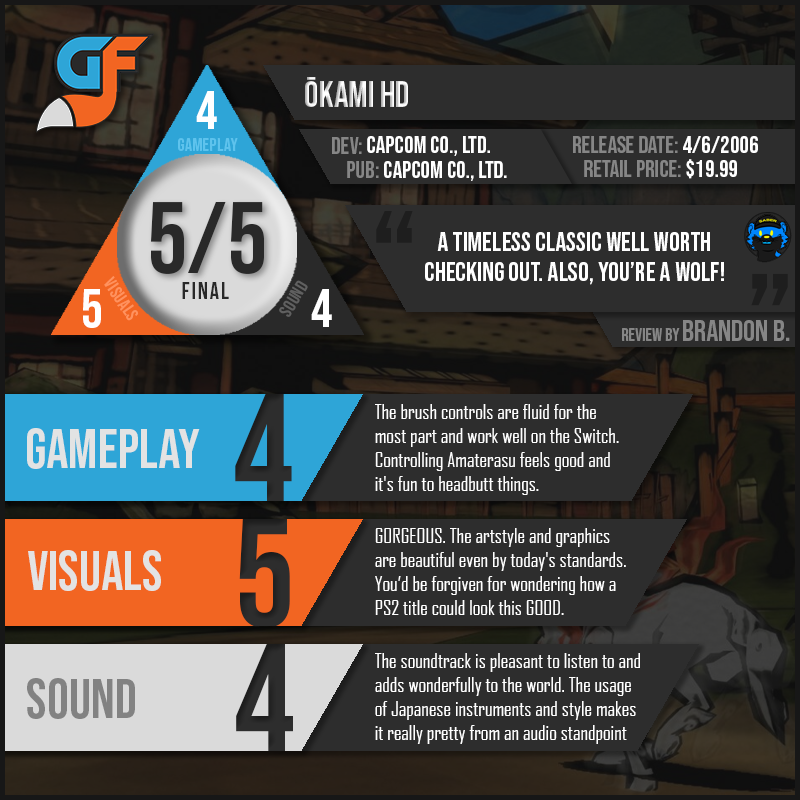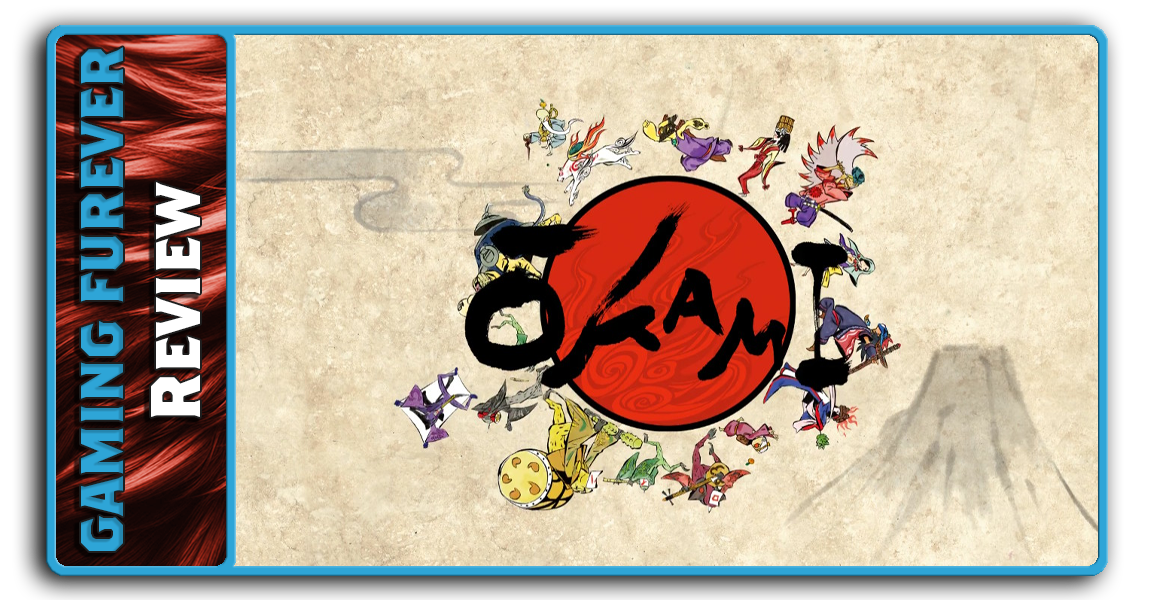The Majestic Wolf Runs
Flowers Bloom Along the Path
And Once Again Spring Beckons
Ōkami is one of the most unique games I’ve played and also one of the most interesting success stories. Odds are, if you’re like me, you’ll have seen Amaterasu the White Wolf around. She’s become a gaming icon of sorts and still shows up at times in games like Marvel vs Capcom. . And yet, she seems like an enigma as unlike Ryu or Chris Redfield, her story isn’t as widely known.
Ōkami was developed by Clover Studio, and released in 2006 for the PS2. Formed by Capcom R&D veterans, Clover Studios' other notable work was adapting Viewtiful Joe for PlayStation 2 and developing its sequel for both PS2 and GameCube. They created only two original works: Ōkami and their last game God Hand. While both were interesting concepts, neither were considered financial successes as they didn’t sell as well as Capcoms more well known franchises. To be fair, Resident Evil 4, which released just a year earlier, set the bar at an unprecedented high which a new IP was probably not gonna come even close to. Despite all that, Ōkami received critical acclaim, nearly around a 9/10 universally at every notable publication. A lot of people noted how Okami’s unique gameplay seemed especially suited to Nintendo’s Wii and DS systems, both of which were very new at the time. The clamor was enough that Ōkami did get a well received port to Wii and while it wasn’t ported to the DS, that system got Ōkamiden, a spiritual successor. The game was later ported to modern consoles in an HD release that has gone on to perform pretty well. The love for Ōkami was still strong and with the 2024 Game Awards shocking announcement of Ōkami 2, now seems like a good time to take a look at this beloved classic.
Underneath A Dark Sky
A Dying Tree Weeps Alone
While Waiting For Dawn To Rise
Ōkami’s story is a simple but effective one. 100 years ago, a malevolent entity known as Orochi threatened the land. The inhabitants of Kamiki Village appeased the entity through sacrifices until one day a swordsman named Nagi teamed up with the white wolf Shiranui and fought Orochi. With the help of Shiranui, Nagi succeeded in sealing Orochi away, saving the village and his beloved at the cost of his canine partner. 100 years later, the legend lives on but is ignored as a greedy man tries to remove Nagis sword from its resting place. This of course frees Orochi and causes evil to spread and darken the land of Nippon(A fictional version of Ancient Japan). Sakuya, the guardian of Kamiki Village calls upon the long dormant sun goddess, Amaterasu who takes on the form of a reincarnated Shiranui. With the help of friendly guide and definitely not a bug Issun, Amaterasu embarks on a quest to restore the land and dispel the curses placed upon it by Orochi. Along the way, Amaterasu encounters various characters inspired by Japanese folklore and history such as Seimei and Queen Himiko. Speaking of Japanese folklore, this game draws on a lot of elements from it to inspire its story and characters. Nippon is even a way of saying Japan in Japanese. The aforementioned Sakuya is based on the Japanese goddess of Mt Fuji who is also known as the blossom-princess. Amaterasu is the Japanese goddess of the sun and the story itself is based on a legend involving a conflict with Yamata no Orochi. It’s a beautifully done tale and plays like an actual adventure. For me, it invoked memories of games like The Legend of Zelda: Twilight Princess. There’s a sense of exploration and excitement that I haven’t felt in a long time. Exploring new areas is always fun and there are always puzzles to be solved. There will be areas or items Amaterasu can’t get right away due to lacking specific brush techniques or items. There’s a thrill to be found in discovering treasure or returning to old areas and unlocking new secrets. It helps that the areas are pretty expansive, with wide fields and humble towns. The game doesn’t lack for visuals nor is it ever boring to traverse the beautiful land of Nippon.
A Suffocating Curse
Rolls Across the Fields
Until the Sun Shines Again
Upon arriving at a new area, a significant part of it will be blanketed in a curse that will drain the life out of Amaterasu if she sets paw in it. Because of this, Amaterasu needs to locate the Guardian Sapling of the area and breathe new life into it. This dispels the curse areas. In order to accomplish this, Amaterasu must make use of the Celestial Brush, Ōkami’s most unique gameplay mechanic. By holding down a shoulder button, players can turn the screen into a canvas and use the thumbstick to draw shapes and solve puzzles. Drawing a circle in the sky for example, will cause the sun to shine. Later, players will get the ability to make trees and plants bloom by drawing circles on them as well as the ability to draw and create bombs. There’s a surprising amount of options and I kept learning new brush techniques as I went along. Speaking of the Celestial Brush, this is where the Nintendo Switch version that I’m playing can be a little different from other versions. The Nintendo Switch port supports touchscreen for the Celestial Brush or the use of the Joy-Con motion controls if you happen to be on TV or Tabletop mode which is really cool. Using the Celestial Brush techniques feels like it was designed for these sorts of controls and works really well, especially when you need to be a bit more precise than a thumbstick can readily provide. This is especially useful in combat as Amaterasu will frequently need to make use of the brush to defeat enemies effectively. While normal enemies can be defeated without it, bosses pretty much mandate it as the Celestial Brush is necessary to expose weak points. Mastering the use of these techniques in battle is essential to acquiring demon fangs, which Amaterasu can exchange with certain NPCs to acquire powerful items. After battle, Amaterasu also gets money which can be spent on recovery items or feed for animals with an extra money being awarded based on how quickly and with how little damage the battle was completed.
Speaking of the animal feed, Amaterasu can give it to the various wildlife and earn praise. Praise, which can also be earned from completing quests and restoring the land, can be used to increase Amaterasu’s stats such as giving her extra health or a bigger pool of ink to use. There are plenty of things to find and collect in the game, like Sun Fragments which also increase Amaterasu’s health or various weapons and unique items. There are even minigames and small puzzles to do in between major story beats. It’s pretty impressive in scope and once you’re past the lengthy tutorial, there’s no shortage of things to do. Fully completing the game is an endeavor, albeit one I found myself looking forward to. It’s a lot of fun to sprint across a field as a wolf or use your jaws to pick up forest creatures. Amaterasu can also do some platforming and headbutting to clear obstacles or reach new areas. There’s a lot of fun to be had though there are also a couple of frustrating points. Like this one section where you have to tie vines to a log within a time limit. You really have to time when to bring out the brush because opportunities to do so are literally blink and you’ll miss it. Beyond that, the game plays beautifully and the usage of the brush is usually pretty forgiving of mistakes. It makes for a pretty fluid experience.
Across The Fields
And Beyond The Trees
A Land Full of History
Ōkami is beautiful and has honestly aged very gracefully. Compared to other PS2 games and even next gen console titles that would be released soon after, Ōkami’s visuals remain timeless. Similar to the Wind Waker(which also aged extremely well visually, especially for a GameCube title), Ōkami also has a cel-shaded flair but in its case, combined with the Ukiyo-e and sumi-e Japanese art styles resulting in a gorgeous watercolor-esque artstyle that just seems to flow as you play the game. Without a doubt, this game is a work of art in every sense, and it feels like I’m moving across a painting. A living painting at that, as Amaterasu will leave a trail of flowers and plants as she darts across the landscape. A visual never gets old and watching the sequences where the land gets restored as beauty and life flow across it is like watching art in motion. This fluidity also extends to the character models. Each NPC has a distinctive almost chibi look and feels like something that would be drawn in a traditional Japanese painting. They aren’t the most detailed of characters but they serve their purpose well. The animals are just as bright and colorful and even the enemies have a distinctive flair. This is a game with a very unique visual style and it works. The sound design is equally on point. Featuring plenty of Japanese instrumentation, the soundtrack can be subtle and effective at times. The charming little notes that play with Amaterasu finds something or when the day/night cycle shifts never get old. While I have yet to find any one piece particularly noteworthy, it’s all really soothing to listen to. Somewhat less soothing are the character voices, which are made up of scrambled samples. It’s not quite the charming Animal Crossing type speech but it's serviceable. Each character has their own different sounding voice which is a pretty nice touch and helps the world feel alive. Though Amaterasu never talks herself, instead that role is filled by Issun. But Ammy does have a dedicated bark button which is really cool.
Overall Ōkami is a wonderful and timeless experience. Playing it takes me back to days long gone where games made linear experiences feel like actual adventures. There’s a feeling of wonder with this game that I haven’t felt since my GameCube days and it's weird to think it’s almost 20 years old. I honestly hope the sequel keeps that sense of wonder. It’s not something I see as much any more.
Night Becomes Day,
The Shadows Recede,
The White Wolf Stands Strong




